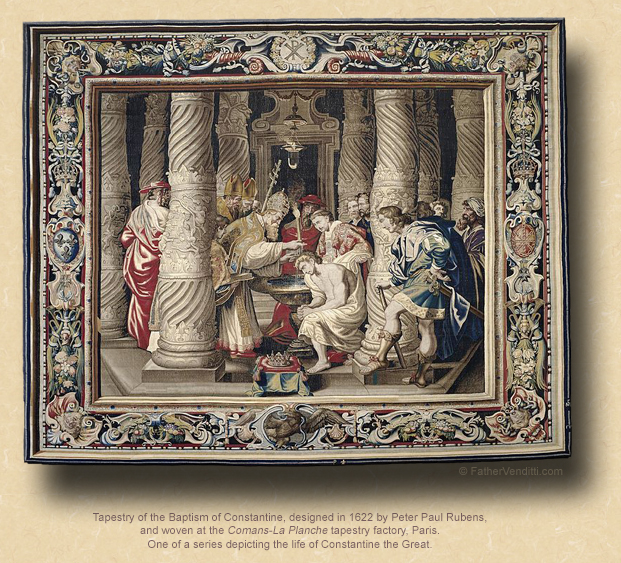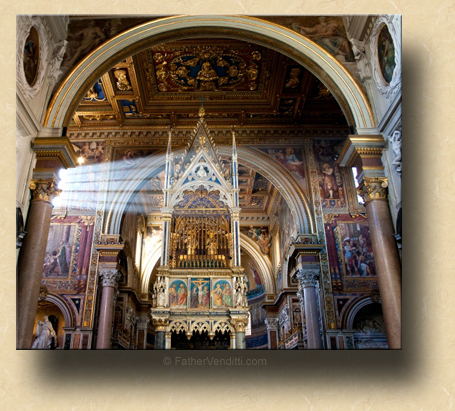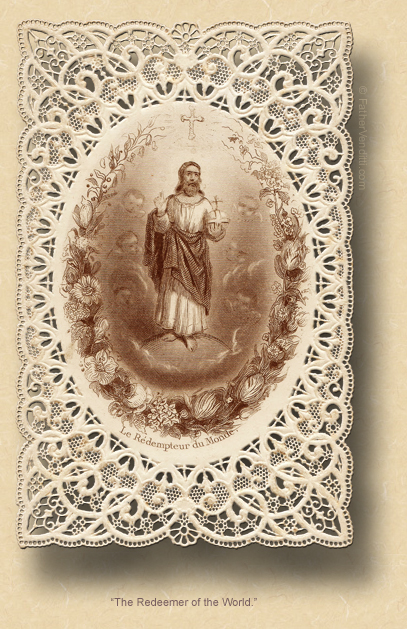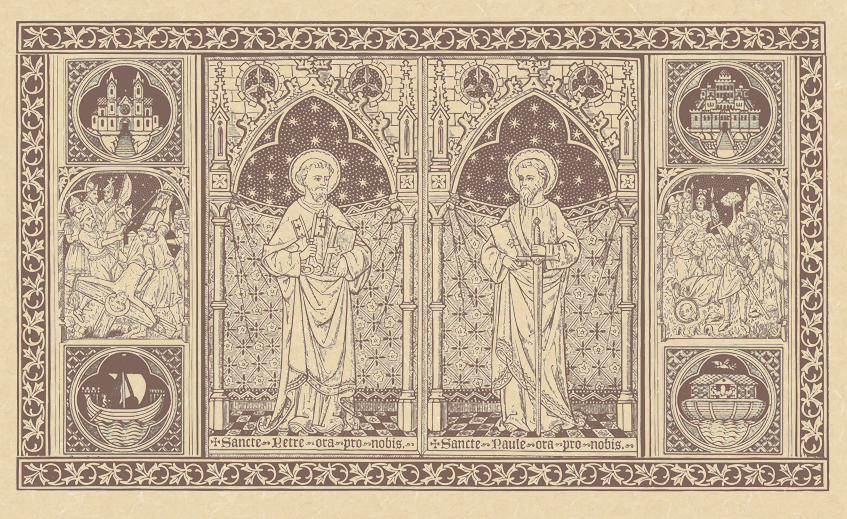Precious Infinitesimals.
The Feast of the Dedication of the Lateran Basilica.
Lessons from the proper, according to the ordinary form of the Roman Rite:
• Exekiel 47: 1-2, 8-9, 12.
• Psalm 46: 2-3, 5-6, 8-9.
• I Corinthians 3: 9-11, 16-17.
• John 2: 13-22.
The Second Class Feast of the Dedication of the Archbasilica of Our Savior; and, the Commemoration of Saint Theodore, Martyr.*
Lessons from the common "Terríbilis…" for the Dedication of a Church, according to the extraordinary form of the Roman Rite:
• Apocalypse 21: 2-5.
• "Locus iste…"**
• Luke 19: 1-10.
|
If a Mass for the Commemoration is taken, it must not be the only Mass of the day, with the lessons from the common "Lætábitur…" of a Martyr not a Bishop:
• II Timothy 2: 8-10; 3: 10-12.
• Psalm 36: 24, 26.
• Matthew 10: 26-32.
|
The Twenty-Second Thursday after Pentecost; the Feast of Our Venerable Mother Matrona; and, the Feast of Theoctista of Lesbos.
Lessons from the pentecostarion, according to the Ruthenian recension of the Byzantine Rite:
• I Thessalonians 2: 9-14.
• Luke 13: 1-9.
FatherVenditti.com
|
9:31 AM 11/9/2017 — Many years ago—more than I care to remember—I was praying one day in the Basilica of Saint John Lateran, and I was approached by a young American tourist, a Protestant, who obviously thought I belonged there, and who began to ask me questions about the Basilica; so, I pointed out to him what I thought was the most significant point about the Basilica: that the baldacchino over the high altar is actually a reliquary which contains the heads of the Blessed Apostles Peter and Paul. A look of astonishment came over his face, and he said, “You mean our Peter and Paul?” By that he meant, “You mean the same Peter and Paul written about in my Protestant Bible?” I didn't volunteer any more information after that. Had I gone on to suggest that he walk over to Saint Mary Major and pray before the manger in which the Child Jesus was lain in Bethlehem, he would have had a stoke.

The Lateran Basilica is so called because it was built on land that was donated to Pope Saint Sylvester I by the Laterani family in 324. Pope Sylvester is important primarily as the one who baptized Constantine, making Christianity the state religion of the Roman Empire; and, thirteen hundred years later, Pope Innocent X would rebuild it, and proclaim it omnium ecclesiarum Urbis et Orbis mater et caput (“mother and head of all churches of Rome and the world”), and named it after the Most Holy Savior.  Only years later would the name of Saint John the Baptist be associated with it. It is the cathedral church of Catholicism and seat of the Diocese of Rome. A lot of people make the mistake of thinking that Saint Peter’s Basilica on the Vatican Hill is the cathedral of Rome and the seat of the pope, but it isn’t; it was merely a church that Constantine had commissioned to be built over the tomb of Saint Peter when it was first discovered; but, until the Avignon papacy in 1309, all the popes lived at the Lateran. To this day, the Lateran remains the cathedral church of the Bishop of Rome. That’s why the first duty of any newly elected pope is go to the Lateran and take possession of it as his cathedral church. All those fancy ceremonies you see in Saint Peter’s Square on television when a new pope is elected don’t mean a thing;—they’re only for the TV cameras—a man is pope because he is the Bishop of Rome, and he is the Bishop of Rome because he sits on the papal throne of the Lateran, underneath the magnificent mosaic of Christ the Teacher. That’s why we don’t celebrate a feast in honor of the dedication of Saint Peter’s, but we do celebrate one in honor of the dedication of the Lateran. It is the mother church of Catholicism. Only years later would the name of Saint John the Baptist be associated with it. It is the cathedral church of Catholicism and seat of the Diocese of Rome. A lot of people make the mistake of thinking that Saint Peter’s Basilica on the Vatican Hill is the cathedral of Rome and the seat of the pope, but it isn’t; it was merely a church that Constantine had commissioned to be built over the tomb of Saint Peter when it was first discovered; but, until the Avignon papacy in 1309, all the popes lived at the Lateran. To this day, the Lateran remains the cathedral church of the Bishop of Rome. That’s why the first duty of any newly elected pope is go to the Lateran and take possession of it as his cathedral church. All those fancy ceremonies you see in Saint Peter’s Square on television when a new pope is elected don’t mean a thing;—they’re only for the TV cameras—a man is pope because he is the Bishop of Rome, and he is the Bishop of Rome because he sits on the papal throne of the Lateran, underneath the magnificent mosaic of Christ the Teacher. That’s why we don’t celebrate a feast in honor of the dedication of Saint Peter’s, but we do celebrate one in honor of the dedication of the Lateran. It is the mother church of Catholicism.
The present church building was commissioned by Pope Innocent X in 1646, and beneath it’s high altar rests the remains of a wooden table which, according to tradition, was used by Peter himself to offer Holy Mass; and, even though Pope Sylvester had decreed that all altars used throughout the church be made of stone, the one exception was the Lateran, where the wooden altar used by Peter himself was always used, and only the pope could offer Mass on it. The church was damaged and repaired many times due to fire, earthquakes, hostile invasions, until a major renovation was ordered by Pope Benedict XIII, a Dominican, who dedicated the current church on April 28th, 1726, and ordered this feast to be celebrated on this day.  Nonetheless, work continued on the church for many years thereafter, principally by Venerable Pope Pius IX and Pope Leo XIII, who finally, in 1884, completed the portico that connects the church to the baptistery where Pope Saint Sylvester had baptized Constantine, some millennia and a half before. Nonetheless, work continued on the church for many years thereafter, principally by Venerable Pope Pius IX and Pope Leo XIII, who finally, in 1884, completed the portico that connects the church to the baptistery where Pope Saint Sylvester had baptized Constantine, some millennia and a half before.
I was a pastor for a long time, and I don’t know how my parishioners would have reacted had I announced a building project that would take more than a thousand years to complete. Maybe that’s what we can take away from our celebration of this feast today: in an age in which the Church seems, at times, to be spinning its wheels pandering to the time-conditioned concerns of the present moment, today’s feast reminds us that a Catholic is someone who has learned to think in centuries, and who must not seek to see the immediate results of his charitable and spiritual efforts. This is a good point to remember when we want to complain that our children have gone astray and can’t figure out what it is we did wrong in raising them. Chances are we did nothing wrong; the seeds of faith we planted in them as children may not bring forth fruit until long after we’re dead. No one ever said we had the right to see the results of the good we do.
Today’s feast is a challenge to that sense of urgency and immediacy that spawns from the sin of pride. Our Lord himself told His disciples that they would reap what they had not sown. I once knew a priest who resisted the bishop’s desire to transfer him elsewhere, claiming that he had not yet accomplished everything he wanted to accomplish in that parish, and who had to be reminded that, if the Gospel and the history of Holy Mother Church teach us anything, it is that the work we begin will almost always be completed by someone else. That’s because what we do in this world is not done for ourselves, but for Him.
Let us pray that the Lord will bless us with a truly Catholic outlook in the broadest definition of that word. Let us ask Him to grant us the grace to see ourselves as precious infinitesimals,*** as He slowly but surely guides us and the world back into union with our creator.

* Theodore, a Christian soldier, was burnt alive at Amasea in the year 304.
** The Gradual is non-Scriptural: "This place was made by God, a priceless mystery; it is without reproof."
*** In mathematics, infinitesimals are things so small that there is no way to measure them. The word infinitesimal comes from a 17th-century modern Latin coinage infinitesimus, which originally referred to the "infinite-th" item in a sequence. Infinitesimals are a basic ingredient in the procedures of infinitesimal calculus as developed by Leibniz, including the law of continuity and the transcendental law of homogeneity.
|

